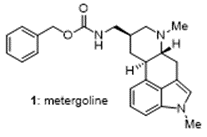Ergot alkaloid antibacterial activity via novel mechanism

Tech ID
23-036
Inventors
E. Brown
J. Magolan
M. Ellis
Z. Piquette
J. Johnson
Patent Status
US provisional filed
Stage of Research
Proof of principle data available
Contact
Leigh Wilson
Associate Director, New Ventures
Abstract
Antimicrobial resistance in Gram-positive and Gram-negative bacteria is a threat to global public health. Indeed, there is a pressing need to develop new antibiotics and adjuvants with new scaffolds and mechanisms of action (MOA). Salmonella enterica serovar Typhimurium (S. Tm) is on the WHO list of priority pathogens as a leading cause of gastroenteritis worldwide and classified as a serious antibiotic resistance threat by the U.S. Centers for Disease Control.
Researchers at McMaster developed a phenotypic high-throughput screen for inhibitors of Salmonella growth within macrophages and identified metergoline as a hit. Further research on the mechanism of action has identified the compound, and potent analogues, bind an alternate binding site in DNA gyrase and represent a distinct biochemical mechanism. Mechanistic details informed on potential further activity of the compounds; compounds were subsequently confirmed as potent inhibitors of MRSA and of fluoroquinolone-resistant strains of S. aureus.
Applications
- Metergoline and analogues are under study as novel antibiotics alone and in combination.
Advantages
- Metergoline and analogues represent a novel mechanism of action.
- Metergoline overcomes resistance mechanisms in clinically-used DNA replication inhibitor antibiotics such as ciprofloxacin, moxifloxacin, etc. The resistance strategies used by clinical pathogens are overcome by this discovery, allowing it to inhibit DNA replication even in multidrug resistant strains such as S. Tm infection.

